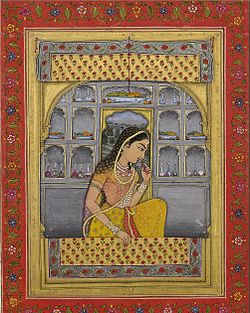Rani Padmini (or Padmavati) was a legendary queen & wife of King Rawal Ratan Singh of Chittor (Mewar). Rani Padmini was known mostly for her divine beauty and Jauhar (self-immolation) in 1303, the year Alauddin Khilji attacked Chittor.
History

Padmini or Padmavati spent her life under the care of her father Gandharvsena and mother Champavati. Padmini had a talking parrot named “Hiramani”. Her father arranged a swayamvara to wed his beautiful daughter to an able man and invited all the Hindu kings and Rajputs (request to marry her by showing their eligibility). King Rawal Ratan Singh of Chittor hearing of Padmini's attributes went to the swayamvara regardless of having multiple wives. There he won her hand by defeating another eligible king, Malkhan Singh. He returned to Chittor with his beautiful queen Padmini.
In the 12th and 13th centuries, the Sultanate of Delhi, set up by Muslim Turkic nomadic invaders, was growing in power. The Sultans made repeated attacks on Mewar. It is famously said and believed that Alauddin Khilji attacked Chittorgarh to have Maharani Padmini all for himself. This story is based on the poem Padmavat by Malik Muhammmad Jayasi, written in Awadhi in 1540. However, some historians do not agree with this story and claim it to be a legend or a famous folklore.
In 1302-03 CE, Chittor was under the rule of Rajput King Rawal Ratan Singh, a brave and noble warrior, and also a patron of arts. He had many skilled and talented artists in his court, one of whom was a musician named Raghav Chetan. But what people did not know was that Raghav Chetan was also a practitioner of magic and spells. He used this hidden talent to defeat his rivals. Unfortunately, he was caught red-handed while practicing magic, which greatly displeased the king. Raghav Chetan was thus banished from the kingdom after he was publicly humiliated when forced to sit on a donkey with black paint on his face and ride around the capital. This harsh punishment earned Ratan Singh an uncompromising enemy. Sulking after his humiliation, Raghav Chetan went to Delhi with the aim of trying to incite the Sultan of Delhi, Alauddin Khilji, with a reason to attack Chittor.
The Sultan on reaching Mewar was anxious to see the beautiful queen Padmini of whose beauty he had heard a lot. As a guest to the kingdom, he asked to meet with the queen. Padmini however, suspicious of Alauddin's demand declined the request. King Ratan Singh then tried to talk his queen into agreeing for he knew of the strength and might of the Delhi Sultanate and the Khilji Dynasty. Padmini then put a condition that Alauddin should see only her reflection that too in the presence of her husband, herself accompanied by a hundred female servants.
When the sultan of Delhi saw her, he was so smittened by her beauty that he wanted Padmini for himself. He thus decided to attack Chittorgarh. He believed that if he killed the king he could have his queen.
The Rajputs fought valiantly in the battle, but lost. Alauddin Khilji, all triumphant when reached the fort was shocked. To his great dismay and disbelief all the royal women including Padmini had committed jauhar.
The women who performed jauhar perished but their memory has been kept alive till date in the bards and songs which glorify their valor. To protect their self respect and honour, they jumped into the fire pyre. To these women death by jauhar was better than the security and luxury of inglorious captivity.
Death
It is believed Maharani Padmini performed Jauhar in 1303, the year Alauddin Khilji attacked Chittor. Jauhar (also spelled jowhar) was the act of self-immolation performed by women, most notably by the queens and royal ladies of the Rajput dynasty, in Rajasthan, after the death of their husbands at the hands of the enemy. These self immolation practices were to save oneself from being taken as a mistress or slave(sex slaves in case of invaders) by the victor, which was not acceptable to the Rajputana Queens, for it symbolized the giving up of their self respect and pride which was of utmost importance to the Rajputs.
Back to list of Famous Rajput Personalities
Most of the information above is courtesy of Wikipedia.
For corrections, additions or comments, please submit a request through contact page.
